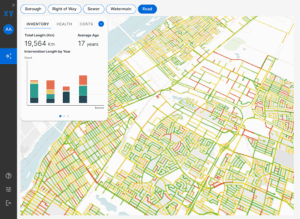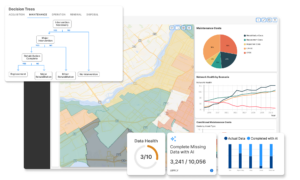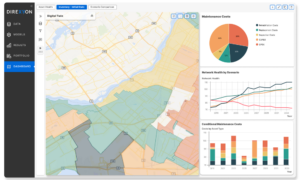Climate resiliency and local water infrastructure investments
Climate change is increasingly impacting our daily lives, and local governments are at the forefront of mitigating the impacts. This is because water infrastructure is managed by local governments. And ultimately, their resiliency comes down to municipal strategy.
By investing in resilient water infrastructure today, municipalities can set their communities up to prosper sustainably, even in the face of historic uncertainty.
What is climate resiliency?
Climate resiliency, adaptation, and mitigation are often used interchangeably. And while they are related concepts, they each have their own meaning.
According to the London School of Economics’ Grantham Research Institute on Climate Change and the Environment, climate resiliency refers to: “the capacity to prepare for, respond to, and recover from the impacts of hazardous climatic events while incurring minimal damage to societal wellbeing, the economy, and the environment.”
Adaptation and mitigation are typically thought of as short-term, incremental, and project-focused. Whereas climate resilience is long-term, holistic, and forward-thinking.
Climate challenges local water infrastructure faces
From unpredictable rainfalls to rising sea levels, more frequent and more severe droughts, climate change is a water issue.
Our existing water infrastructure stands to be impacted in the following ways:
Heavy rainfall and flooding
Warmer oceans increase the amount of water that evaporates into the air. When that moisture-laden air makes landfall or converges into a storm system, it results in heavier rain.
When water infrastructure is hit with heavy rainfall it wasn’t designed for, it can overwhelm stormwater systems. And this leads to sewers overflowing and contaminating water supplies.
Floodwaters can damage water treatment facilities, pipelines, and pumping stations. This creates lengthy service disruptions and costly repairs.
Rising temperatures
When the mercury rises above 30 degrees Celsius, it’s only natural that people will turn on the taps to cool off.
Irrigation, cooling, and personal consumption all put additional pressure on water infrastructure. Even water infrastructure that was installed 15 years ago wasn’t designed to handle annual record-breaking heat. The increased demands degrades assets faster, causing it to break more frequently.
Rising sea levels
For coastal communities, rising sea levels and more frequent storms pose a significant risk to water treatment plants, sewage systems, and distribution networks.
As natural and man-made barriers erode, the likelihood of saltwater intruding increases. Saltwater can not only degrade assets faster, but compromises drinking water supplies.
Investing in resilient water infrastructure
Higher temperatures, rising sea levels, and extreme weather speed up the deterioration of water infrastructure, leading to more breaks and failures.
Options to address this include installing new flood barriers, waterproof pump motors, or replacing old water pipes. The best choice depends on the municipality’s location, size, and climate.
However, every local government will face the exact same challenge: finding the resources.
Safe, clean drinking water and efficient wastewater disposal rely on complex infrastructure networks. Since these systems are underground, repairing, replacing, and assessing them can be costly.
Thankfully, there are actions municipalities can take to optimize their spending and create climate resilient water systems.
Water infrastructure asset management
Managing assets and asset management might seem similar, but they are different.
Managing assets is reactive. Crews fix issues like breaks as they happen.
Asset management is proactive. It plans for the entire lifecycle of infrastructure, considering future performance, risk, and cost.
Proactive asset management extends infrastructure life, minimizes downtime, and prevents costly repairs. It increases efficiency and reduces expenses, creating resilient infrastructure.
To develop proactive asset management, you need reliable data. A complete inventory of water assets, including size, location, material, and performance history is essential.
Learn more: What asset data do municipalities need to track?
Asset Investment Planning for water infrastructure
Proactive asset management is crucial for extending the life and resilience of water infrastructure. However, assessing various investment scenarios can be challenging and often needs specialized solutions.
Asset Investment Planning (AIP) software helps with this. It allows cities to simulate the impact of upgrading critical pipelines and other infrastructure. This helps prioritize improvements.
For example, a city can simulate the impact of upgrading critical pipelines and dumps for climate resiliency. Comparing the performance of these upgrades to existing infrastructure can help prioritize improvements.
The city can also simulate adding permeable pavements and retention basins. While upfront costs are higher, the long-term savings in risk and performance can be significant.
Additionally, the city can model scenarios with and without federal and provincial support.
AIP solutions enable local governments to quantify the long-term benefits and tradeoffs of specific investments. This helps them demonstrate the need for climate-resilient infrastructure and optimize within existing constraints.
Create your climate-resilient investment scenarios
Direxyon offers turnkey Asset Investment Planning solutions for municipal governments.
Our transparent and user-configurable solutions have helped local governments:
– Develop their asset management plans
– Reduce infrastructure deficits
– Deliver the desired levels of service for less annual investment.
To find out more how Direxyon can help you invest in climate-resilient water infrastructure and long-term sustainability, contact us today.






